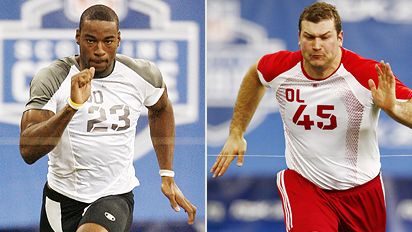What follows is the first part of a three-part series which I am calling "Are Mock Drafts Really Accurate?" This will be an exploration of the validity of mock drafts. In "Part I: The Question," I will fill in the background leading to the question of the mock draft's relevance in the NFL. In "Part II: Data and Analysis," I will present the data which I have uncovered through extensive research of a few selections of last year's mock drafts and explain how the data reveals the accuracy of each mocker. And in the final part, entitled "Part III: The Truth," I will conclude the results of the examination. Let's begin.
PART I: THE QUESTION

Everybody is an expert these days. Mel Kiper, Jr. (pictured right) made it popular, and now everybody seems to be doing it. Mock drafts are the latest craze in what seems to be a never ending offseason for NFL fans. Once the last second ticks off the clock of the Super Bowl, the season ends (with the exception of the Pro Bowl), and we must wait yet another seven months to plan our Sundays around the television. In the meantime, football does not go into hibernation but disappears behind the closed doors of bargaining offices until the start of a new season.
During this hiatus, we speculate on the changes made to our favorite teams through free agency, trades, and the draft. The draft gives fans the opportunity to see if their teams' general managers and scouts are living up to their potential and increasing salaries by fulfilling teams' needs. But how do we really know for sure whether or not a player has the talent to make that walk to the podium on day one of the draft, hearing his name called as he shakes hands with and hugs his posse before donning the hat and jersey of his new team? How can we be sure where a player will place in the draft and with what team? Who determines the placement of these players?
As I mentioned before, everybody is an expert these days. Mel Kiper, Jr is the "official" draft expert in the NFL, and his mock drafts have been the "standard" to which most mock draftsmen aspire. As a result, the mock draft has quickly become one of the main ways in which fans can "predict" which player will be drafted by their teams. A lot of work goes into constructing these mocks, and writers work day and night to rate these players so that football fans can have all of the necessary information going into this major event; however, the question still remains:
Can you really see the future when looking at a mock draft, as if it is a crystal ball, or are those who compile these lists filling everyone full of hot air?
I seriously doubt that NFL head coaches, general managers, and scouts are sitting in the "war room" prior to selection with stacks of printouts from the DraftKing or Mel Kiper's page to determine which college standout will be their franchise running back. The simple fact is that mock drafts are meant for our entertainment. And when I say "our," I mean you and I, the general population of football fanatics. Let's face it, the casual fan doesn't read the latest three-round mock draft released by Huddlegeeks. Yet, someone has to hold the mock experts accountable. Let's begin our journey.
When examining five mock drafts from last year--Mel Kiper's mock draft, DraftKing, Football's Future, Sports Nutz, and NFL Draft Countdown--and comparing them to the results of the 2006 draft, we may find some interesting results. Although some mockers have only been brave enough to develop a first-round projection, others have published three-round mocks, and in Mel Kiper's case, a four-round mock. The modern day draft runs for seven rounds, although in it's advent in 1982, it was a 12-round event. Even today, constructing a seven-round mock draft would be quite an undertaking.
Photograph of Mel Kiper, Jr. taken from ESPN.com.


